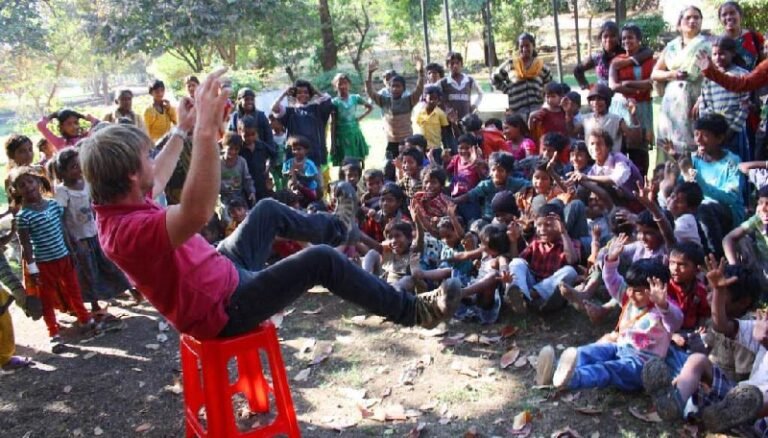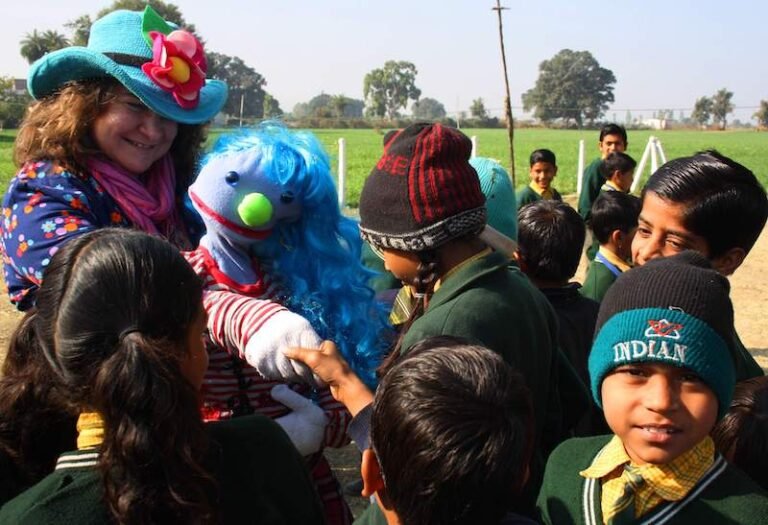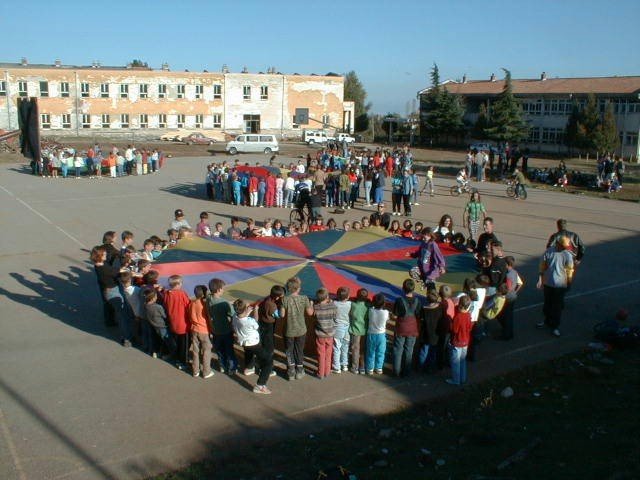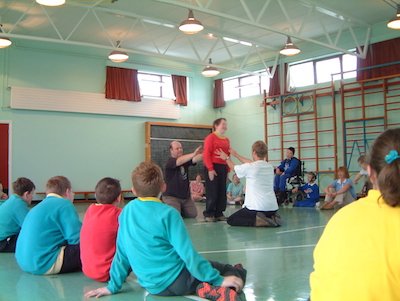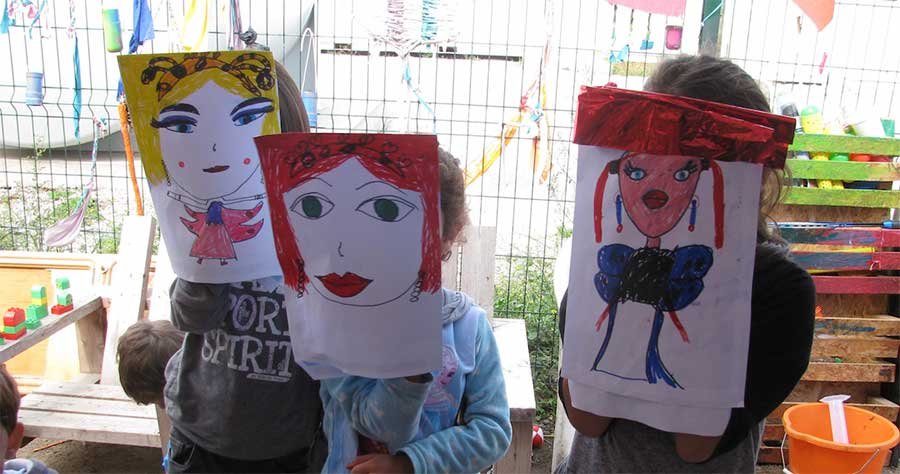IN PARTNERSHIP WITH THE BHOPAL MEDICAL APPEAL
CWI have done a few tours since it’s creation in 1999. We have worked in countries affected by war and natural disaster but this is the first time we have been to a place devastated by a corporation’s economic greed! It is hard to believe that although the original poisoning occurred nearly 30 years ago, the land around the plant is still contaminated and people are still living there and children are playing in the factory grounds!
From the 8th – 23rd January 2013 CWI in partnership with the Bhopal Medical Appeal sent a 4 person team to provide a two hour programme of Performance, Fun and Games to children and families still affected by the tragic poisoning. Both charities felt that our programme of laughter and entertainment would be a real boost and be of real value. And we felt it was right to remember the ongoing plight of the people affected – the area is still toxic, people are still suffering!
Our first show was at the Nawab Colony which is right next door to the factory on marsh land which was part of the “Solar Evaporation” area that Union Carbide used to dump their contaminated water. It was slightly disconcerting to find that we were performing in the same area that appeared in the acclaimed documentary “Bhopali” that showed that all that protected the land and water from the toxic waste were what looked liked sheets of bin bags!
Everywhere we performed we were able to speak to people about their experience and indeed the ongoing effects. No place highlighted the ongoing effects more than our visit to the Chingari Rehabilitation Centre which works with children born with birth defects, disabilities, or life threatening conditions due to the ongoing pollution and contamination of their environment. The youngest child we met there was 18 months old!
During our time in Bhopal we managed to run a total of 16 shows and reached an estimated 4500 children and families! All the shows were either in schools and communities directly affected by the disaster or were recommended as worthy by the Bhopal Medical Appeal and/or the Sambhavna Clinic in Bhopal.
We were able to donate a parachute to the Aayaam School in Bhopal who have a large number of autistic children in their care. We were also able to donate a small generator and PA system to the Sambhavna Clinic. They have a lot of volunteers who visit and the equipment can be used by them to continue to provide entertainment for the community.
CWI would like to thank the Bhopal Medical Appeal for their partnership of our trip and for providing us with an amazing guide and “tour manager” Mr Sanjay Verma. We would also like to offer our grateful thanks for the generous support of Aggreko and the Anne Harris Children’s Fund without whose help this tour could not have happened.
A day by day blog of our tour can be found by hitting the Facebook button on the left of this screen.
Team member Dinah Mason has written a short piece about the trip – see below.
IMPRESSIONS OF THE TEAM’S TOUR – BY DINAH MASON
Coming home from taking part in the Childrens World International trip to Bhopal, I have been left with some very vivid memories of places and people which have made a marked impression on me. In writing this I hope to paint a picture – not of a day by day account, but of some of those memories, impressions, thoughts and feelings which have stayed so strongly with me.
We were based at Sambhavna Clinic in the heart of Old Bhopal. This part of the city reminded me of descriptions I had read of old Medieval London – twisty tangles of confusing alleyways, clogged with dirt and rubbish, where scrawny dogs scavenge, children play and street sellers push carts piled with onions and carrots. Here goats roam – bizarrely dressed in old jumpers and frayed shawls which their owners believe they need against the cold (cold??!!) of India’s winter. The buildings where people live and work are a higgledy-piggledy mix – comparatively posh houses rubbing shoulders with slum dwellings built of whatever can be found. There was a feeling in many areas of confusion between construction and destruction – which reminded me of bomb sites and glimpses of the innards of buildings where the walls have been ripped off (or, in this case, never put on). Some structures appear to be half built, then abandoned and later added to by others, accounting for the strange sight of skeletal three or four storey buildings, within which shack-type dwellings sprout here and there, small and seeming to cling tight in precarious nooks and crannies like barnacles on a ship. The main streets are jammed with traffic – buses, cars, lorries, auto rickshaws, all driving as fast as the frequent jams will allow, all blaring horns deafeningly. Amongst the mayhem handcarts are manhandled, and cows wander peacefully oblivious, munching on the rubbish which seems to be their staple diet.
We settled in at Sambhavna Clinic which is run by a man called Satu – a farsighted individual, passionate about providing healthcare for the local people affected by the Gas Disaster at the Union Carbide pesticide factory in December 1984. To be as accessible as possible to the worst affected areas and people, Sambhavna is situated only 400metres from the factory site. The factory still stands, deserted and too contaminated to enter safely – the laboratories are still there, equipment and bottles of chemicals strewn around and thickly choked with toxic dust. There is a wall around the site, where here and there are holes bashed in, through which children clamber to go and play, unaware of the danger. Sambhavna provides community health care daily to many people.
Everyone we met there was friendly, welcoming and helpful – none more so than our guide and interpreter, Sanjay. He is a survivor of the Gas Disaster. A baby at the time, he was saved by his older sister aged 9. She awoke on that horrific night to find all her family and neighbours choking to death on the poisonous fumes leaking in a silent lethal smog from the factory, engulfing Old Bhopal. She wrapped Sanjay in a blanket and ran as far and as fast as she could, managing to save them both despite the choking fumes. Thousands were killed, or died later from the effects of the gas. Others were permanently disabled, blinded, and many thousands of people are still suffering with resultant chronic diseases today. Sanjay lost both parents and all but two siblings that night. He and his sister lived in an orphanage for the next ten years. His older brother survived the immediate disaster, but was left to contend with a black despairing depression because of it – he committed suicide some years later. I learned that terrible emotional and mental health problems are a common legacy affecting these people.
Having said that, Sanjay is definitely a Survivor of the tragedy – one of the amazing, strong-willed, hopeful and energetic people we met, all doing what they can to make a difference.
The Gas Disaster devastated not only the lives of people as a direct effect that night, but in far-reaching and on-going effects on the environment they live in. The ground and water were very heavily contaminated with numerous deadly poisons still present and dangerous today. When it rains the ground water rises and the contamination flows freely in the streets where children play. Many communities are supplied from bore holes fed with this contaminated water. Years of being forced to use this for all daily needs results in chronic illness – occurrences of all sorts of cancers are very high, as are other diseases. This situation also accounts for why so many babies are still being born, even today, with terribly debilitating conditions, physical and learning disabilities, chronic illness, facial deformities, and sight, hearing and speech problems.
One community we took our show to was just outside the Union Carbide factory wall. It was built like a sort of shanty town on the sludgey ground which is the result of Union Carbide’s so-called Solar Evaporation Programme. In other words, the toxic sludge from the Gas Disaster was dumped here, and covered roughly in some bin bag-style flimsy plastic sheeting to prevent seepage. We could see the layers of sludge and the now tatty and rotted sheeting. It does not work. The people who live here know the danger they are in, and attempt to keep out of it by way of makeshift stepping stones of rocks and planks. As I tottered from stone to stone, carrying kit for our show from the van to the community building (a concrete-built empty shell), my foot slipped and squelched into the sludge. A boy nearby also slipped, and was sharply scolded and smacked for doing so – a scolding out of fear for his safety rather than anger, I could see. This is what they live with every day. This place in particular made me feel upset and angry for these people. If Union Carbide and the Indian Government did nothing else, could they at least be given safe ground to live on and clean water piped in? It seems that Union Carbide (now owned by Dow Chemicals) and the Government have washed their hands of them (only of course in nice clean water, far far away from Bhopal).
The CW Team took a programme of interactive fun, games and performance to a variety of schools, clinics and community spaces. In different ways all the places made a big impression on me. Not least was the Chingari Trust – a combined school and treatment centre for children with physical and learning disabilities. Chingari was founded and is run by survivors of the Gas Disaster, notably women who through the loss of husbands and fathers now find their roles and lives completely changed. Previously they would have experienced little of life and people outside the home, and now they are breadwinners, carers for children and relatives, workers at Chingari. These are very inspiring people who have had to find and use a political voice, becoming active in the campaign for justice. At Chingari the children are taught everyday skills, receive physiotherapy, speech therapy and other treatment. They also have the chance to learn, play and just be with other children. Previously a lot of these children would be kept hidden in the home. This place also offers practical and emotional help to families as a whole – particularly to mothers, who in the past were seen as a burden or, even worse, abandoned along with disabled children. Such a place and such a different attitude cuts through the isolation and depression affecting many of the women.
Everywhere the team went, both our work and ourselves were enthusiastically welcomed. Audiences ranged from children and teachers in schools, to families and people of all ages in the clinic, community buildings, open spaces and once squashed into a very narrow street! The open spaces in particular got very uproarious! Not only did everyone very much enjoy the shows, but also really loved the informal contact offered through the more “off the cuff” games and activities. They really wanted to talk to us as much as varied English skills on their part, and practically no Hindi on our part, allowed. Despite language differences I found that through a mix of play, mime and puppetry, quite in-depth conversation was often possible with the children. Many teachers and other workers had a lot of English. And of course Sanjay was on hand to translate too. On one or two occasions the roles were reversed and we were treated to beautiful performances by very small children of song and dance, once in a school for autistic children – and once we were met at the school gate by the children’s band and presentations of bunches of flowers. Probably the nearest we will ever get to feeling like celebs!!
All the people we met were so appreciative of our being there, and for what they saw as proof that they are not forgotten. They also very much enjoyed the creative spectacle of the shows and the time we spent just being with them, playing, talking and listening. I am also very appreciative of the friendly welcome and kindness we encountered there, often from those who have practically nothing themselves. I remember a little boy who I had spent time playing with during the show, coming up to me afterwards, wanting to share his very small lunch with me. I didn’t accept! But hope I left him knowing how touched I was.
I am left with a vivid memory of people working hard in tough times with great energy, practicality, steadfast dedication and active hope that their endeavours will build a better future.

